9 Chapter 9: Social Reconstructionism
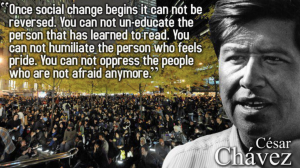
Social Reconstructionism is an educational philosophy focused on reconstructing society. This educational philosophy was spear headed by a group of progressive educators known as the “Frontier Thinkers” in the 1920s and 1930s (Webb et. al., 2010). The goal of the Frontier Thinkers was to create a more “equitable” society. To achieve such a society, the Frontier Thinkers called for social reform because they believed the educational system was not adequately addressing critical societal issues like war, prosperity, and depression (Webb et. al., 2010).
This chapter will provide an overview of the key characteristics of Social Reconstructionism as well as key information related to how this philosophy of education approaches the curriculum. Information on the instructional methods used within this philosophy and a discussion of the role of the teacher and role of the learner will also be provided. Finally, key proponents of Social Reconstructionism and their contributions to this philosophy of education will be presented.
Characteristics of Social Reconstructionism
9.1 Essential Questions
By the end of this section, the following Essential Questions will be answered:
- Is the philosophy of Social Reconstructionism student-centered or teacher-centered? Why?
- What philosophies can Social Reconstructivism be traced to?
- This philosophy calls for a critical examination of two key things. What are they and what are the implications of exploring these issues?
- What does it mean to be a “change agent?”
The philosophy of Social Reconstructionism is a student-centered philosophy. This philosophy is rooted in the belief that education should be focused on reconstructing society. This emphasis is a result of the perceived lack leadership on the part of schools to create an equitable society.
According to Webb et. al. (2010), this philosophy of education can also be traced to the philosophies of both pragmatism and existentialism. Pulling from these philosophies, Social Reconstructivists call for a critical examination of all cultural and educational institutions (Webb et. al., 2010). Based on this examination,areas that are found to be lacking should be identified and recommendations for change and/or reform should be made according to this philosophy.
This philosophy is also very idealistic in nature, in that it encourages schools to teach students to dream about “what might be” rather than settle for “what is” (Webb et. al., 2010). As such, students are encouraged to be “change agents” by challenging the norm and seeking to make society a better place for everyone. In order to be a change agent, student are asked to look at inequities in society and think of ways to address these inequities by taking action. For example, students might discover that a local animal shelter is going to be shut down due to lack of funds so they might work together to raise the money to keep the shelter in business.
Sadker and Zittleman (2010) expand on this example by stating that the purpose of education, according to this philosophy of education, is to encourage “schools, teachers, and students to focus their studies and energies on alleviating pervasive social inequities and, as the name implies, reconstruct society into a new and more just social order” (p. 284). This focus on eliminating social injustices is indeed the cornerstone of Social Reconstructionism.
9.2 A Closer Look
The following article, titled: Social Reconstructivism for Urban Students, provides a closer look at Social Reconstructivism in action. As you read the article, please think about some of the key characteristics you have learned about Social Resonstructionism in this section. When you are done reading the article, please respond to the Questions to Consider.
- What are some of the attributes of resilient urban students?
- What is service learning?
- What role do teachers play in the Social Reconstructivist curriculum according to this article?
- What can we learn from Mrs. James?
- What are some beneficial outcomes of Student Workshops?
- What did you learn about Social Reconstructivism that you did not know before reading this article?
Curriculum
9.3 Essential Questions
At the end of this section, the following Essential Questions will be answered:
- What is the focus of the Social Reconstructivist curriculum?
- What is the “hidden curriculum” and how do Social Reconstructivist challenge it within their curriculum?
- What is the nature of the curriculum within the Social Reconstructivist classroom?
- Do you think the focus of this curriculum is beneficial for students? Why or why not?
Social Reconstructivists firmly believe in the power of democracy to change society for the better. Therefore curriculum within the Social Reconstructivist classroom reflects “democratic ideals and emphasizes civic education” (Webb et. al., 2010, p. 87). Based on this emphasis, the curriculum provides students with the opportunity to engage in service learning opportunities that would provide them with first-hand experiences to study social problems and controversial issues.
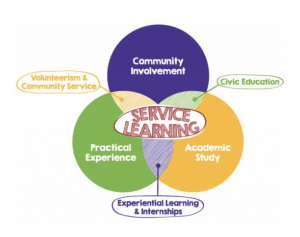
In addition, the curriculum in a Social Reconstructivist classroom emphasizes critical theory and the development of critical literacy or critical thinking skills (Webb et. al., 2010). This means that students are challenged to think critically by reflecting on inequities found in society and exploring them. For example, students might be studying the issue of gender inequity in the past and be asked to relate it to gender inequity issues that are still going on today. The key, according to Reeves (2013), is that the curriculum material presented to the students not only sheds light upon social inequities, it should also provoke an emotional response within the students so that they feel called up to take action and come up with ways to address the inequities they identify.
Blake & Masschalein (2003) note that a Social Reconstructivist curriculum challenges all unequal power relationships and focuses on power as applied to class, gender, sexuality, race, and nationalism. One of the most unequal power relationships that is currently challenged by this curriculum is that which exists within schools. This unequal power is disguised in the hidden curriculum that is taught every day to students. This hidden curriculum “represents the knowledge, claims, and values of the dominant group or class that controls the schools” (Gutek, 2004, p. 319). This hidden curriculum is brought to light, explored, and challenged within the Social Reconstructivist curriculum.
9.4 A Closer Look
For a more in-depth overview of the hidden curriculum, please read the article titled: What are we learning right now? As you read this article, please think about the following Questions to Consider:
- How does the article define the hidden curriculum?
- Which three sources of the hidden curriculum, as identified in “Sources of the Hidden Curriculum” chart, stood out to you the most? What are the implications of knowing these for you as a future teacher?
- What is one key take-away you got from the article?
In summary, the nature of the curriculum within the Social Reconstructivist classroom, should:
- Inform students.
- Stir emotions within students.
- Shed light upon social inequities.
- Improve students abilities to think critically.
- Charge students to take action. (Reeves, 2013)
In doing all of these things, the curriculum will not only improve students abilities to think critically about problems in society, it will also help them become the responsible citizens the founders of this philosophy envisioned. Students studying this curriculum will be able to take matters into their own hands and make positive changes that will improve society for the better.
9.5 A Closer Look
The following video provides an overview of Social Reconstructivism. As you watch it, consider the information you have learned about Social Reconstructivism so far and ask yourself: What links can I make between the information in the video and the information in the chapter? After watching the video, please respond to the Questions to consider that have been provided as well.
- What are the three main goals of this philosophy?
- Who was one of the key Reconstructivists? What were their contributions to this philosophy?
- How do the theories and ideas mentioned in the video come together in the classroom?
- What were some example of Social Reconstructivist lessons that could be done in the classroom?
Instruction in the Classroom
9.6 Essential Questions
By the end of this section, the following Essential Questions will be answered:
- What are the instructional methods focused on in a Social Reconstructivist classroom?
- What do Social Reconstructivist teacher do to support students learning?
- What is the teachers role in the classroom?
- What is the students role in the classroom?
Social Reconstructivism is focused on looking at what is wrong is society and seeing how it can be improved. Therefore, the instructional methods used in the classroom are focused on problem solving, critical thinking, research, and cooperative learning (Webb et. al., 2010). Unlike other philosophies where teachers approach instruction with very specific objectives in mind, Social Reconstructivist teachers are less authoritarian and more focused on meeting the individual needs of the student (Sadker and Zittleman, 2010). In other words, this method of instruction is more student-centered.
Within this student-centered approach to instruction, Reeves (2013) found that Social Reconstructionist instructors:
- Spend less time lecturing and more time allowing students to work in cooperative groups.
- Facilitate instruction, guiding students in the direction they need to go, but never mandating the direction students should take.
- Encourage student to form their own opinions based on what they think and what their research has told them, not what they are told to think by the teacher.
Based on this approach to instruction, students are supposed to have the skills they need to take action make changes that will positively improve society.
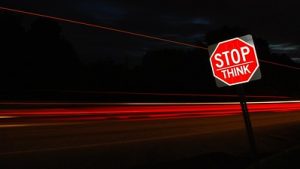
- What do you think of the student-centered approach of the Social Reconstructivist classroom is effective? Why or why not?
- If you had to follow this instructional method, how would you inspire your students to make changes that would positively improve society? Please provide at least two specific examples.
Teachers Role
The role of the Social Reconstructivist teacher is constantly changing as a result of the changing nature of society. Consequently, metaphors like “shaper of a new society,” “transformational leader,” and “change agent” have been used to describe the Social Reconstructionist teacher (Webb et. al., 2010). In order to be an effective Social Reconstructivist teacher, teachers must be willing to undergo constant change and updating of their personal and professional lives and have a very high tolerance for ambiguity.
According to research by Revees (2013), the teachers role in the Social Reconstructivist classroom includes:
- Creating a safe and democratic environment for their students so that lessons and topics may be discussed, debated, and all students voices will be heard.
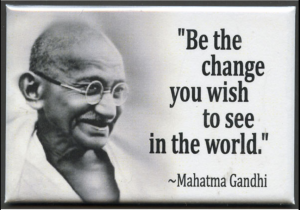
- Presenting students with material that looks into social injustices so that their students know that these injustices exist.
- Creating lessons to inform students but also evoke an emotional response from their students.
- Being fearless in presenting material to students.
- Setting up a democratic environment in the classroom.
- Inspiring students to be the change they wish to see in the world.
- Helping to shed light on social inequities.
- Providing students with the knowledge they need and the critical thinking skills to process it in meaningful ways so they can make positive changes in society.
In order to accomplish all of these tasks, Social Reconstructivist teachers have to take on a leadership role in the classroom so that they can effectively facilitate student learning.

- Do you think you could be a Social Reconstructivist teacher given the ambiguity involved in this philosophy?
- If you were an Social Reconstructivst teacher, how would you create a safe and democratic learning environment (give 2-3 specific examples)?
Students Role
Within this philosophy, students are called upon to be “change agents.” As such, they are guided by their instructors to explore issues of inequality in society and figure out ways to address them. People who do not believe in this philosophy would say that students can not really have any significant impact on society. However, “Social Reconstructionist believe that students are the critical element in bringing about social change” (Webb el. al., 2010, p. 85).
With the guidance of the teacher, it is the role of the student to initiate change by first identifying inequities in society. They then work together with their peers to research and problem solve ways to address these inequities. Finally, they engage in active, project-based learning, or service learning outside the school to become immersed in the societal problem they have identified and apply the possible solutions they have developed (Webb et. al., 2010). Please take a moment to reflect on the information you have learned about instruction and the teacher and students roles in a Social Reconstructionist classroom.
9.7 A Closer Look
- Do you feel like you would be an effective Social Reconstructivist instructor based on the information shared in this section? Why or why not?
- How did the quotes in the video inspire you? How do you think they would inspire students to be “change agents?” Please provide 2-3 specific examples.
- In what ways might the instructional strategies shared in this section and in the video support students to become “change agents?” Please provide 2-3 specific examples.
Key Proponents
9.8 Essential Questions
By the end of this section, the following Essential Questions will be answered:
- Who were the key proponents of Social Reconstructionism?
- What impact did each of the key proponents of Social Reconstructionism have on this philosophy of education?
The Social Reconstructionist philosophy of education emerged in the 1930s, however, it was probably most popular in the twentieth century (Webb et. al., 2010). Key philosophers who influenced the development of Social Reconstrctionism were Karl Marx, George S.
Counts, Theodore Brameld, and Paulo Freire. In this section, a brief overview of each of these philosophers and their contributions to Social Reconstructionism will be presented. As you read about each philosopher and the information presented on their contributions,
please reflect on the similarities and differences among them.
Karl Marx (1818-1883)
Karl Marx is best known for writing the Communist Manifesto (Marx & Engels, 1848). In this book, Marx explores issues related to the struggles experienced among different social classes and problems of capitalism. He also presented his theories about the nature of society and politics (SparkNotes Editors, 2011).
As one of the first people to explore issues of inequality, Marx set the stage for Social Reconstructionism.
9.9 A Closer Look
The following article provides more information on how Marx’s work can be linked to Social Reconstructionism today. As you read the article, please respond to to the Questions to Consider that have been posed to help you make valuable links to the information being shared in this article.
- What are some of the roots of Marx’s work?
- Based on the information in the article, what links did you find between Marx’s work and Social Reconstructionism?
George S. Counts (1889 – 1974)
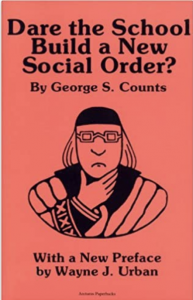 George S. Counts is one of the earliest advocates of Social Reconstructivism. In 1932, he gave a speech to the Progressive Education Association titled: Dare the Schools Build a
New Social Order. In this speech, he called upon schools to focus less on the student and more on the social issues of the time (Webb et. al., 2010). This speech was one of three that became the foundation for a slim volume that was later published and called Dare the School Build a New Social Order?
George S. Counts is one of the earliest advocates of Social Reconstructivism. In 1932, he gave a speech to the Progressive Education Association titled: Dare the Schools Build a
New Social Order. In this speech, he called upon schools to focus less on the student and more on the social issues of the time (Webb et. al., 2010). This speech was one of three that became the foundation for a slim volume that was later published and called Dare the School Build a New Social Order?
9.10 A Closer Look
For a detailed bibliography on George S. Counts and his contributions to Social Reconstructionism, please read the following article: George S. Counts: Leading social reconstructionist. After reading this article, please respond to the Questions to Consider.
- What was Counts educational outlook?
- How did Counts use the term indoctrination? Was it a positive or negative perception of the educational system?
- What as the AFT and how was it important to Counts?
- In what way was Counts involved with the FBI?
- Based on everything you read, what did you learn about Counts role in the development of Social Reconstructionism?
Theodore Brameld (1904 – 1987)
Theodore Brameld was an American educator and educational philosopher. In 1945, he called for a new social order that challenged social inequities like prejudice, discrimination, and economic exploitation in an article titled: Minority Problems in Public Schools, published in The Social Frontier Journal.
Brameld was considered by many to be one of the founders of Social Reconstructivism. He had a very utopian view of Social Reconstructivism and wanted to see changes take place in America as well as abroad. For this reason, he ideas were often criticized as being too utopian in nature.
9.11 A Closer Look
For more information on Theodore Brameld, please watch the following video clip. As you are reading the article, please think about the following Question to Consider:
- What did you learn about Theodore Brameld?
- What was his international view on Social Reconstructionism?
- What did Brameld believe the creation of a new social order would fulfill?
- Do you agree with Brameld’s philosophy? Why or why not?
Paulo Freire (1921 – 1997)
Paulo Freire was born in Recife, Brazil in 1921. He is best know for his book, Pedagogy of the Oppressed, which was first published in Portuguese in 1968. In 1969, it was published in English as Spanish. Ironically, it was not published in his native country of Brazil until 1974 due to the political feuds taking place between Freire and the military dictatorships running the country at the time.
9.12 A Closer Look
To learn more about the powerful work and contributions to Social Reconstructionism made by Paulo Freire, please read the following article titled: A pedagogy of possibility: Reflecting upon Paulo Freire’s politics of education: In memory of Paulo Freire.
- What is the pedagogy of critical literacy and why was is so important to Paulo Freire?
- How did Freire influence critical pedagogy in North America?
- What are six learning principles we have gained from Freire’s work?
- What are some shortcomings that have been linked to Freire’s work?
- What is the main message you have taken from reading about Freire’s work?
- How might you use what you have learned in your future classroom?
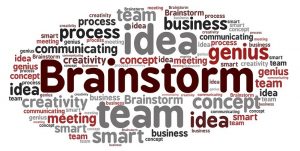
Reflect on your learnings about Social Reconstructionism. Come up with one “real- world” example of your own that illustrates this philosophy being applied in practice in an educational setting.
Once you find your example:
- Make a copy of it and/or have the complete APA citation for it AND,
- Write a one paragraph summary (5-6 sentences) that states why/how it is an example of Social Reconstructionism.
Acceptable examples in practice include:
- a newspaper article or story,
- a journal article or book,
- or a YouTube clip.
Media Attributions
- Introductory Quote Social Reconstructionism © unknown author
- Service Learning Model © Red Rocks Community College
- Stop and Think © DWRose
- Gandhi Quote © Peacemonger.org
- Counts © George S. Counts
- Brainstorm

